Real-Time and Meter-Scale Absolute Distance Measurement by Frequency-Comb-Referenced Multi-Wavelength Interferometry
Abstract
:1. Introduction
2. Methods
2.1. Principle of Multi-Wavelength Interferometry
2.2. Explanation for NAR Extension
3. Experimental Setup
4. Experimental Results and Discussion
4.1. Preparative Test
4.2. Linear Distance Measurement
4.3. Long-Term Comparison
5. Conclusions
Acknowledgments
Author Contributions
Conflicts of Interest
References
- Berkovic, G.; Shafir, E. Optical methods for distance and displacement measurements. Adv. Opt. Photonics 2012, 4, 441–473. [Google Scholar] [CrossRef]
- Estler, W.T.; Edmundson, K.L.; Peggs, G.N.; Parker, D.H. Large-scale metrology—An update. CIRP Ann. Manuf. Technol. 2002, 51, 587–609. [Google Scholar] [CrossRef]
- Pellegrin, S.; Buller, G. Laser-based distance measurement using picosecond resolution time-correlated single photon counting. Meas. Sci. Technol. 2000, 11, 712–716. [Google Scholar] [CrossRef]
- Bobroff, N. Recent advances in displacement measuring interferometry. Meas. Sci. Technol. 1993, 4, 907–926. [Google Scholar] [CrossRef]
- Williams, C.C.; Wickramasinghe, H.K. Absolute optical ranging with 200-nm resolution. Opt. Lett. 1989, 14, 542–544. [Google Scholar] [CrossRef] [PubMed]
- De Groot, P. Unusual techniques for absolute distance measurement. Opt. Eng. 2001, 40, 28–32. [Google Scholar] [CrossRef]
- Diddams, S.A.; Jones, D.J.; Ye, J.; Cundiff, S.T.; Hall, J.L. Direct link between microwave and optical frequencies with a 300 THz femtosecond laser comb. Phys. Rev. Lett. 2000, 84, 5102–5105. [Google Scholar] [CrossRef] [PubMed]
- Udem, T.; Holzwarth, R.; Hänsch, T.W. Optical frequency metrology. Nature 2002, 416, 233–237. [Google Scholar] [CrossRef] [PubMed]
- Kim, S.-W. Metrology: Combs rule. Nat. Photonics 2009, 3, 313–314. [Google Scholar] [CrossRef]
- Minoshima, K.; Matsumoto, H. High-accuracy measurement of 240 m distance in an optical tunnel by use of a compact femtosecond laser. Appl. Opt. 2000, 39, 5512–5517. [Google Scholar] [CrossRef] [PubMed]
- Jang, Y.-S.; Lee, K.; Han, S.; Lee, J.; Kim, Y.-J.; Kim, S.-W. Absolute distance measurement with extension of nonambiguity range using the frequency comb of a femtosecond laser. Opt. Eng. 2014, 53, 122403. [Google Scholar] [CrossRef]
- Joo, K.-N.; Kim, S.-W. Absolute distance measurement by dispersive interferometry using a femtosecond pulse laser. Opt. Express 2006, 14, 5954–5960. [Google Scholar] [CrossRef] [PubMed]
- Van den Berg, S.A.; Persijn, S.T.; Kok, G.; Zeitouny, M.G.; Bhattacharya, N. Many-wavelength interferometry with thousands of lasers for absolute distance measurement. Phys. Rev. Lett. 2012, 108, 183901. [Google Scholar] [CrossRef] [PubMed]
- Jin, J.; Kim, Y.-J.; Kim, Y.; Kim, S.-W.; Kang, C.-S. Absolute length calibration of gauge blocks using optical comb of a femtosecond pulse laser. Opt. Express 2006, 14, 5968–5974. [Google Scholar] [CrossRef]
- Salvadé, Y.; Schuhler, N.; Lévêque, S.; Le Floch, S. High-accuracy absolute distance measurement using frequency comb referenced multiwavelength source. Appl. Opt. 2008, 47, 2715–2720. [Google Scholar] [CrossRef] [PubMed]
- Hyun, S.; Kim, Y.-J.; Kim, Y.; Jin, J.; Kim, S.-W. Absolute length measurement with the frequency comb of a femtosecond laser. Meas. Sci. Technol. 2009, 20, 095302. [Google Scholar] [CrossRef]
- Baumann, E.; Giorgetta, F.R.; Coddington, I.; Sinclair, L.C.; Knab, K.; Swann, W.C.; Newbury, N.R. Comb-calibrated frequency-modulated continuous-wave ladar for absolute distance measurements. Opt. Lett. 2013, 38, 2026–2028. [Google Scholar] [CrossRef] [PubMed]
- Ye, J. Absolute measurement of a long, arbitrary distance to less than an optical fringe. Opt. Lett. 2004, 29, 1153–1155. [Google Scholar] [CrossRef] [PubMed]
- Cui, M.; Zeitouny, M.G.; Bhattacharya, N.; van den Berg, S.A.; Urbach, H.P.; Braat, J.J. High-accuracy long-distance measurements in air with a frequency comb laser. Opt. Lett. 2009, 34, 1982–1984. [Google Scholar] [CrossRef] [PubMed]
- Wei, D.; Takahashi, S.; Takamasu, K.; Matsumoto, H. Experimental observation of pulse trains’ destructive interference with a femtosecond frequency-comb-based interferometer. Opt. Lett. 2009, 34, 2775–2777. [Google Scholar] [CrossRef] [PubMed]
- Lee, J.; Kim, Y.-J.; Lee, K.; Lee, S.; Kim, S.-W. Time-of-flight measurement using femtosecond light pulses. Nat. Photonics 2010, 4, 716–720. [Google Scholar] [CrossRef]
- Coddington, I.; Swann, W.C.; Nenadovic, L.; Newbury, N.R. Rapid and precise absolute distance measurements at long range. Nat. Photonics 2009, 3, 351–356. [Google Scholar] [CrossRef]
- Liu, T.-A.; Newbury, N.R.; Coddington, I. Sub-micron absolute distance measurements in sub-millisecond times with dual free-running femtosecond Er fiber-lasers. Opt. Express 2011, 19, 18501–18509. [Google Scholar] [CrossRef] [PubMed]
- Lee, J.; Han, S.; Lee, K.; Bae, E.; Kim, S.; Lee, S.; Kim, S.-W.; Kim, Y.-J. Absolute distance measurement by dual-comb interferometry with adjustable synthetic wavelength. Meas. Sci. Technol. 2013, 24, 045201. [Google Scholar] [CrossRef]
- Wang, G.C.; Jang, Y.-S.; Hyun, S.; Chun, B.J.; Kang, H.J.; Yan, S.H.; Kim, S.-W.; Kim, Y.-J. Absolute positioning by multi-wavelength interferome-try referenced to the frequency comb of a femtosecond laser. Opt. Express 2015, 23, 9121–9129. [Google Scholar] [CrossRef] [PubMed]
- Dändliker, R.; Thalmann, R.; Prongue, D. Two-wavelength laser interferometry using superheterodyne detection. Opt. Lett. 1988, 13, 339–341. [Google Scholar] [CrossRef] [PubMed]
- Tilford, C.R. Analytical Procedure for Determining Lengths from Fractional Fringes. Appl. Opt. 1977, 16, 1857–1860. [Google Scholar] [CrossRef] [PubMed]
- Le Floch, S.; Salvadé, Y.; Mitouassiwou, R.; Favre, P. Radio frequency controlled synthetic wavelength sweep for absolute distance measurement by optical interferometry. Appl. Opt. 2008, 47, 3027–3031. [Google Scholar] [CrossRef] [PubMed]
- Jones, D.J.; Diddams, S.A.; Ranka, J.K.; Stentz, A.; Windeler, R.S.; Hall, J.L.; Cundiff, S.T. Carrier-envelope phase control of femtosecond mode-locked lasers and direct optical frequency synthesis. Science 2000, 288, 635–639. [Google Scholar] [CrossRef] [PubMed]
- Jost, J.D.; Hall, J.L.; Ye, J. Continuous tunable, precise, single frequency optical signal generator. Opt. Express 2002, 10, 512–520. [Google Scholar] [CrossRef]
- Chun, B.J.; Hyun, S.; Kim, S.; Kim, S.-W.; Kim, Y.-J. Frequency-comb-referenced multi-channel fiber laser for DWDM communication. Opt. Express 2013, 21, 29179–29185. [Google Scholar] [CrossRef] [PubMed]
- Udem, T.; Reichert, J.; Hozwarth, R.; Haensch, T.W. Absolute optical frequency measurement of the Cesium D1 lines with a mode-locked laser. Phys. Rev. Lett. 1999, 82, 3568–3571. [Google Scholar] [CrossRef]
- Ciddor, P.E. Refractive index of air: New equations for the visible and near infrared. Appl. Opt. 1996, 35, 1566–1573. [Google Scholar] [CrossRef] [PubMed]
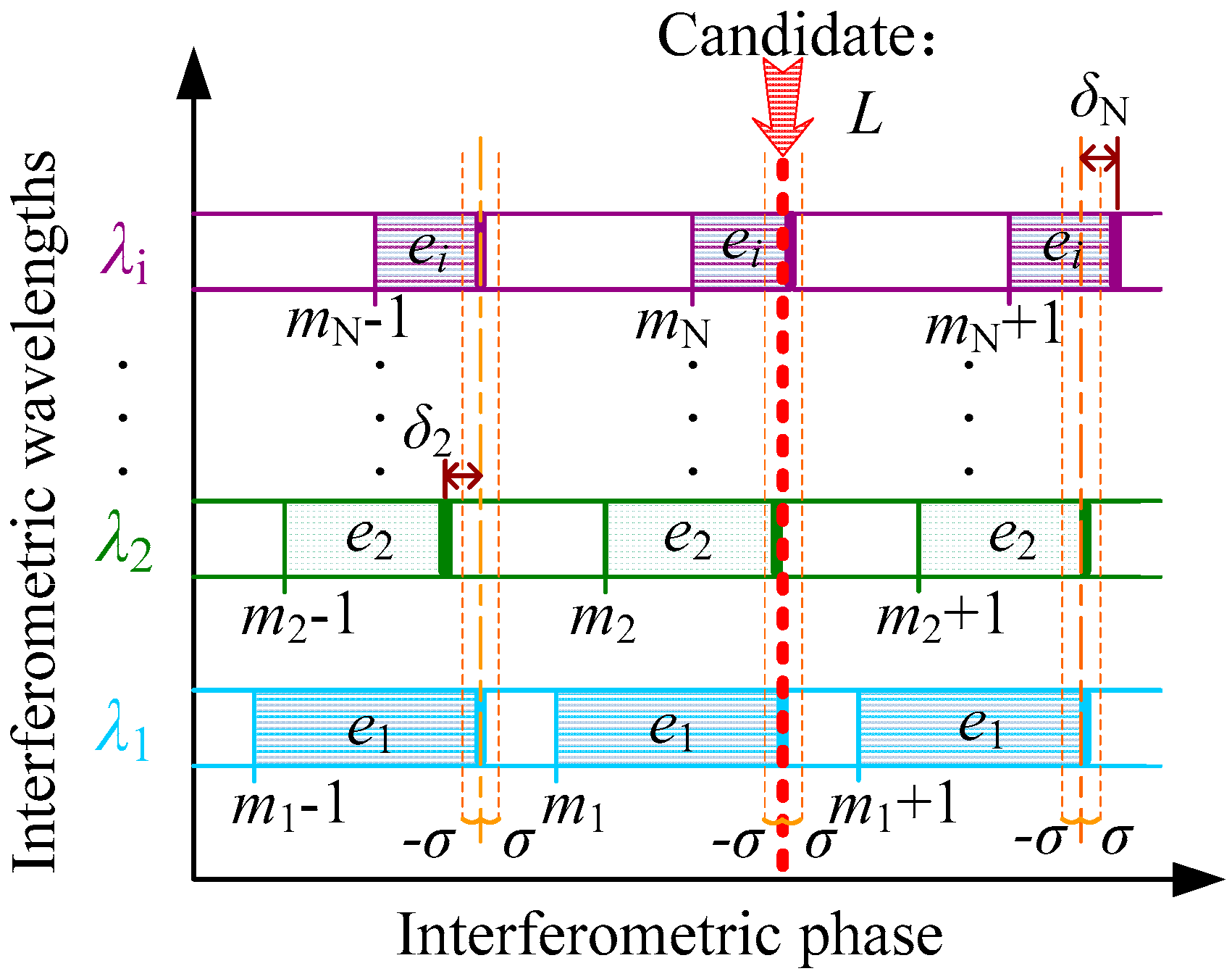
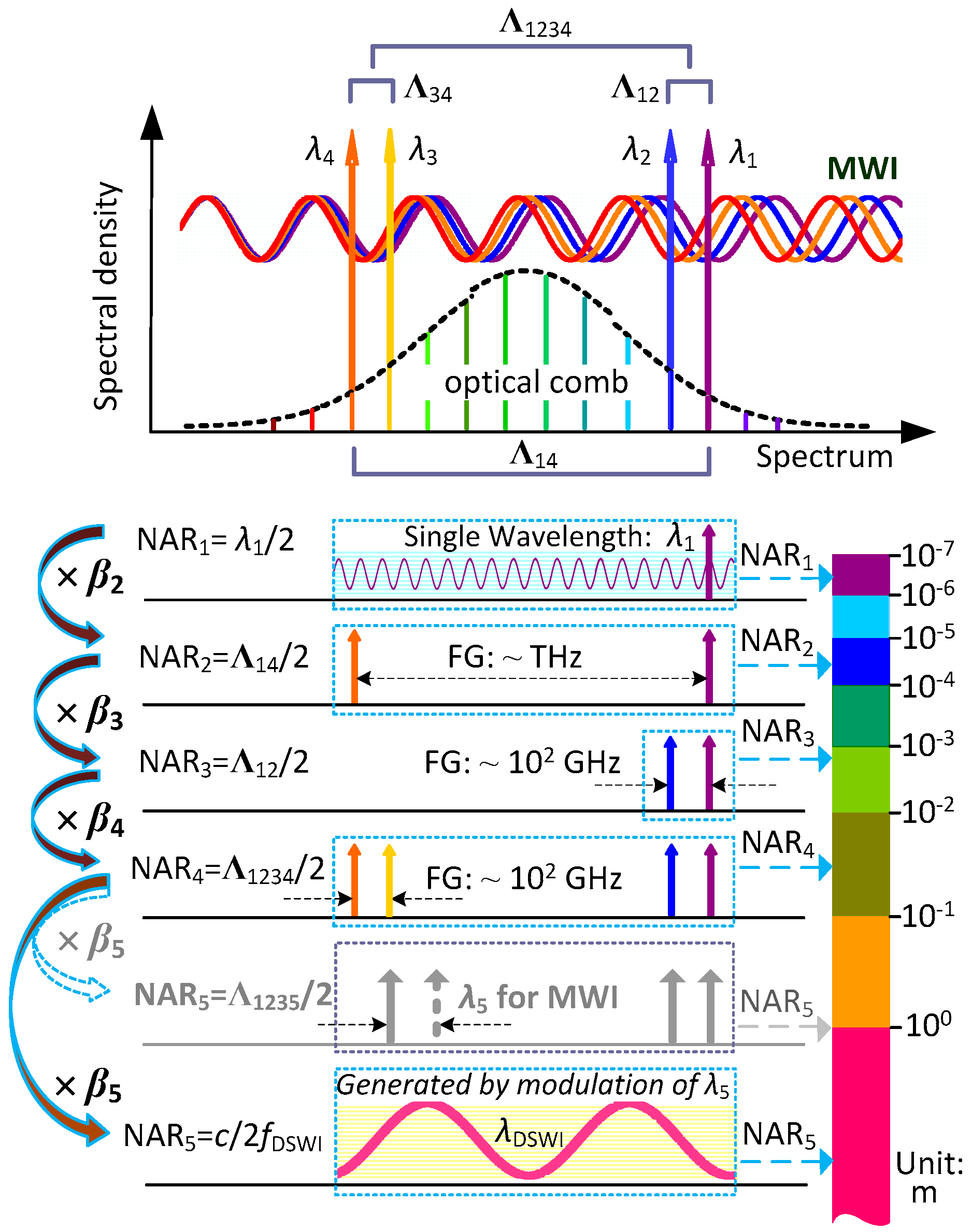

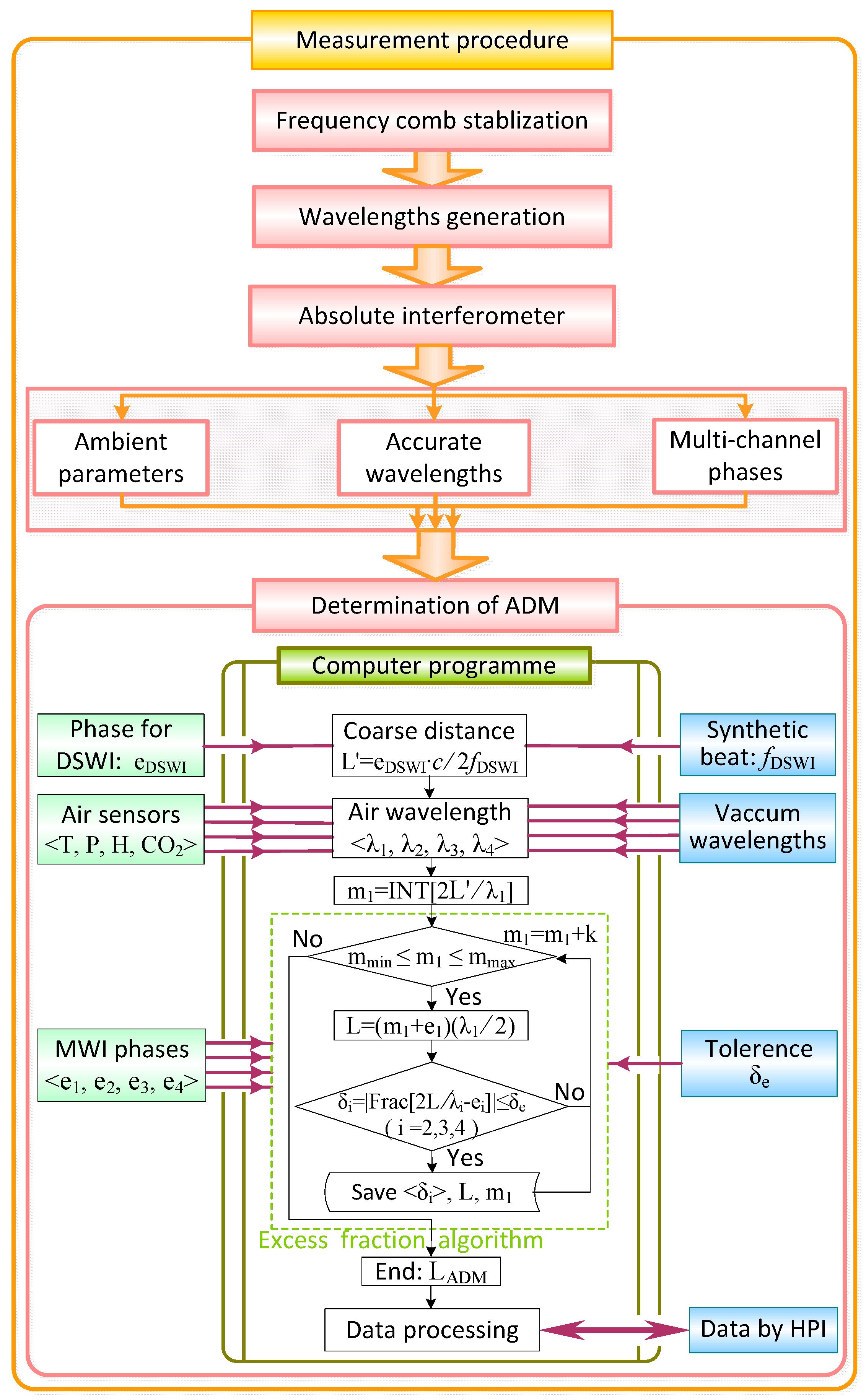
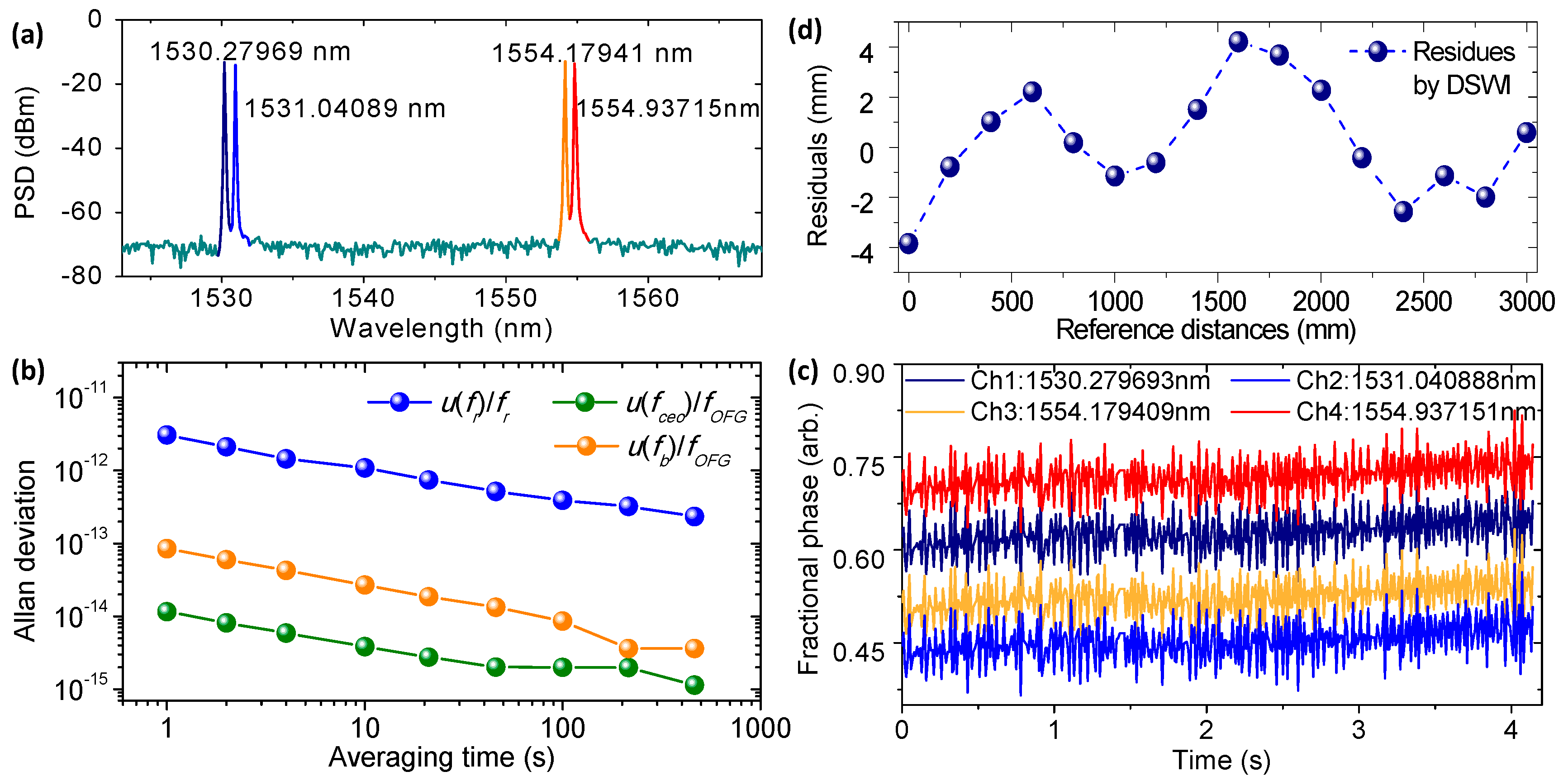
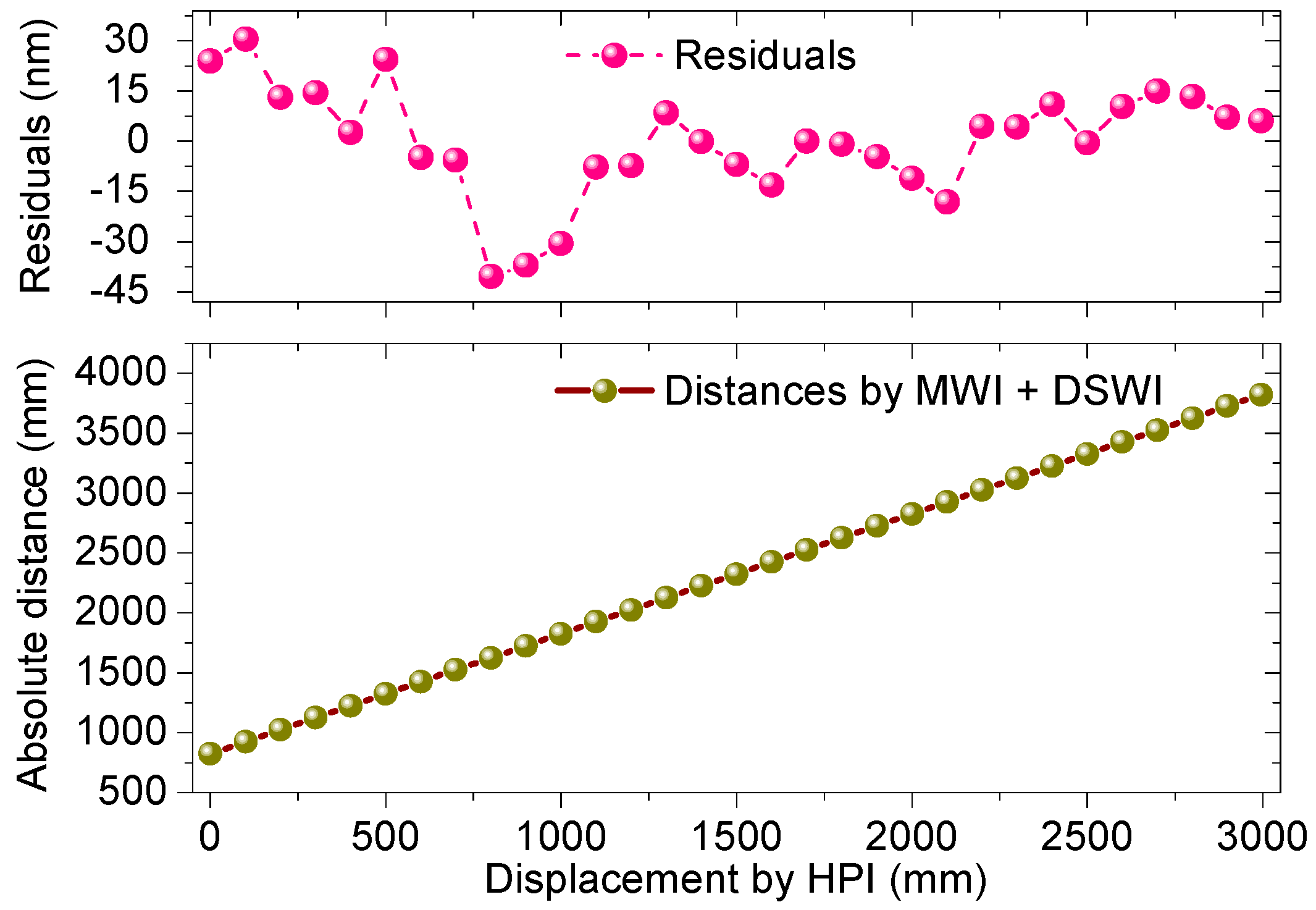
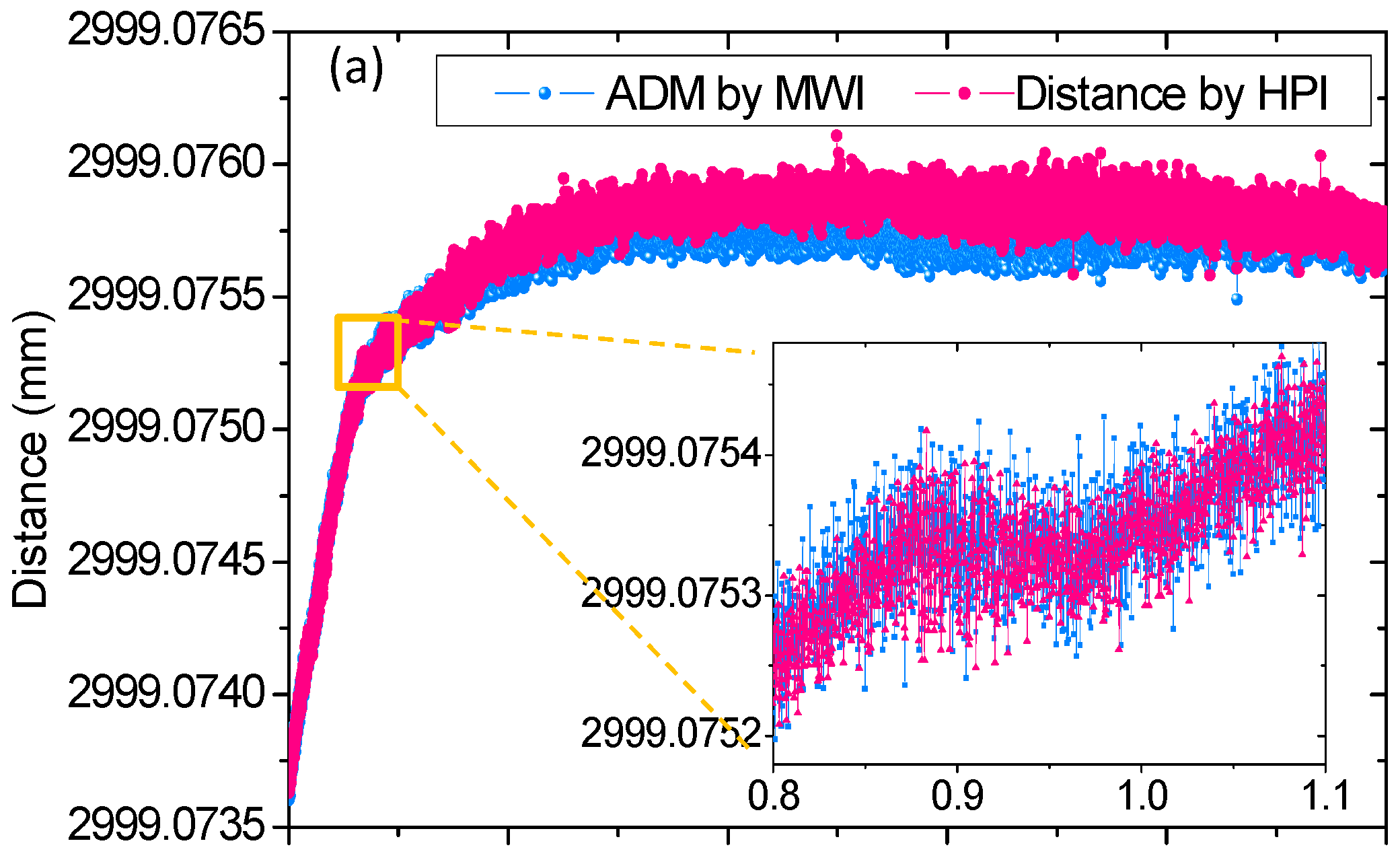
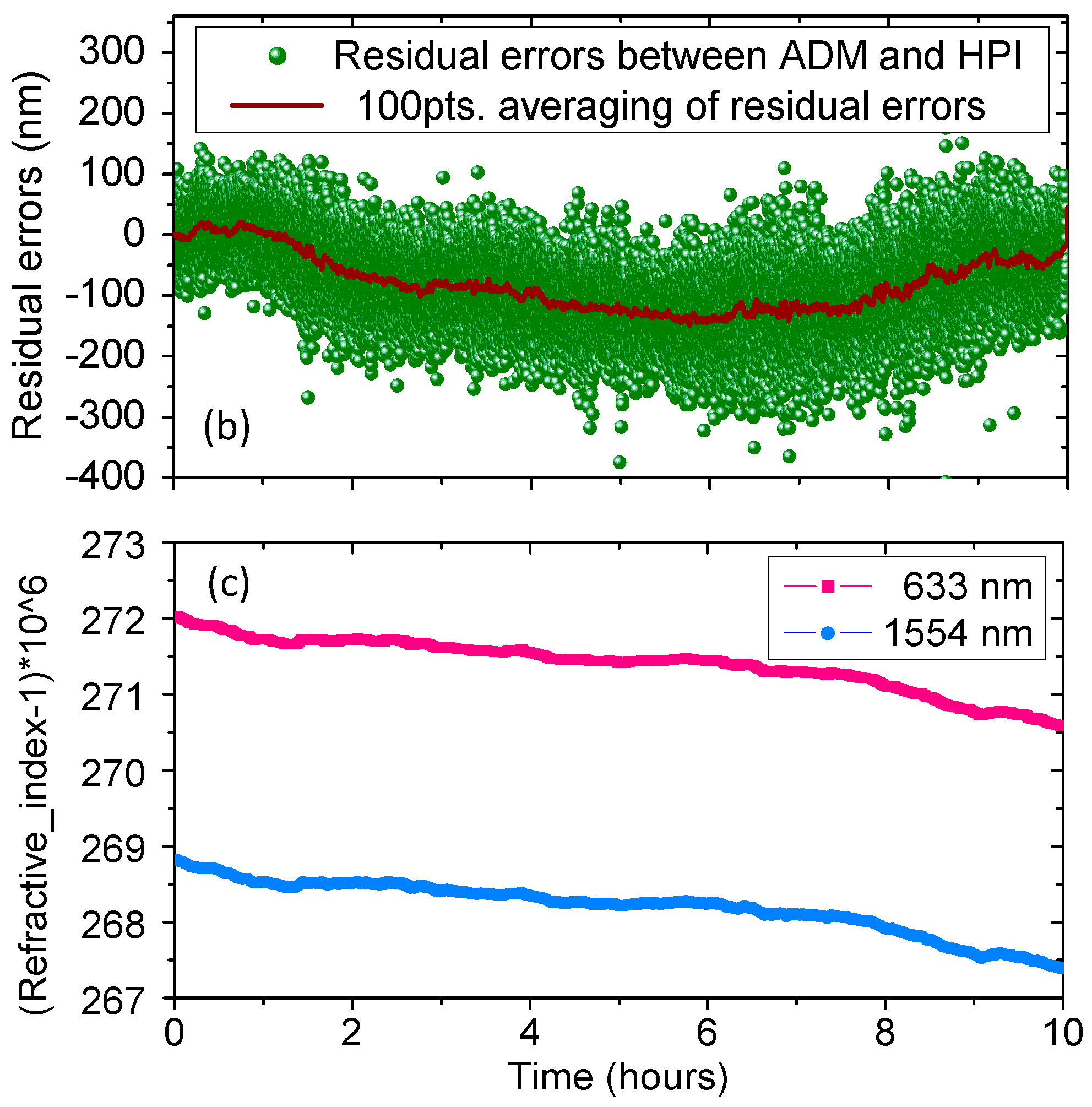
| NAR Chain | NAR1 (λ1/2) | NAR2 (∧14/2) | NAR3 (∧12/2) | NAR4 (∧1234/2) |
|---|---|---|---|---|
| λ1 = 1530.279693 nm | √ | √ | √ | √ |
| λ2 = 1531.040888 nm | √ | √ | ||
| λ3 = 1554.179409 nm | √ | |||
| λ4 = 1554.937151 nm | √ | √ | ||
| Quantity of NAR | 765 nm | 45 μm | 1.7 mm | 45 mm |
© 2018 by the authors. Licensee MDPI, Basel, Switzerland. This article is an open access article distributed under the terms and conditions of the Creative Commons Attribution (CC BY) license (http://creativecommons.org/licenses/by/4.0/).
Share and Cite
Wang, G.; Tan, L.; Yan, S. Real-Time and Meter-Scale Absolute Distance Measurement by Frequency-Comb-Referenced Multi-Wavelength Interferometry. Sensors 2018, 18, 500. https://doi.org/10.3390/s18020500
Wang G, Tan L, Yan S. Real-Time and Meter-Scale Absolute Distance Measurement by Frequency-Comb-Referenced Multi-Wavelength Interferometry. Sensors. 2018; 18(2):500. https://doi.org/10.3390/s18020500
Chicago/Turabian StyleWang, Guochao, Lilong Tan, and Shuhua Yan. 2018. "Real-Time and Meter-Scale Absolute Distance Measurement by Frequency-Comb-Referenced Multi-Wavelength Interferometry" Sensors 18, no. 2: 500. https://doi.org/10.3390/s18020500
APA StyleWang, G., Tan, L., & Yan, S. (2018). Real-Time and Meter-Scale Absolute Distance Measurement by Frequency-Comb-Referenced Multi-Wavelength Interferometry. Sensors, 18(2), 500. https://doi.org/10.3390/s18020500






